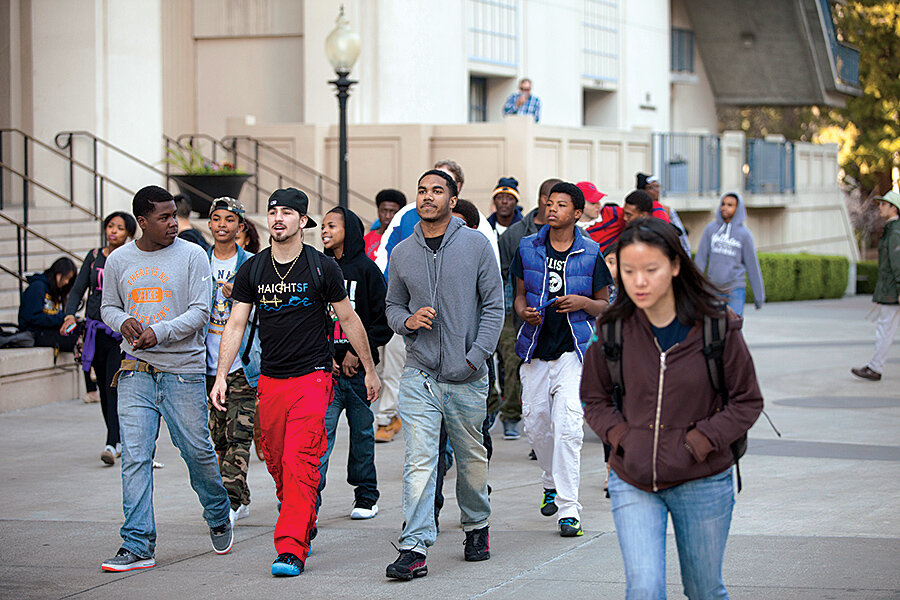Good Reads: From helping low-income students, to aging workers, to Justice Stevens
Loading...
Chemistry professor David Laude runs a program at the University of Texas at Austin aimed at helping high-achieving students from low-income families earn a four-year degree, the most powerful force for economic mobility for low-income Americans.
In a New York Times Magazine story Paul Tough notes that more than 40 percent of students who start at four-year colleges don’t manage to earn a degree after six years. Research shows that whether a student manages to graduate depends to a large degree on how much money the student’s parents make, not on the student’s test scores. Professor Laude has found that to help low-income students succeed, schools need to go beyond dealing with financial and academic obstacles. “You also need to address their doubts and misconceptions and fears,” Mr. Tough writes. When students are reassured both about belonging in a selective college and about their native ability, the gap in graduation rates between advantaged and disadvantaged students was cut in half.
Emerging needs of an older workforce
The Economist examines the major consequences of what it calls a “staggering rise in the number of old people” in the next 20 years. The number of those ages 65 and older is projected to leap from 600 million to 1.1 billion worldwide.
On the positive side of the ledger, highly educated people are increasingly working well into what was considered old age, thus continuing to contribute to economic activity. A key challenge is the growing employment gap between well-educated individuals and less-skilled workers. Some 65 percent of American men ages 62 to 74 with a professional degree are in the workforce. Only 32 percent of men in that age bracket with a high school education are still employed.
Changes in pension, education, and tax policies will be needed to deal with the exploding elderly population. But the magazine cautions, “The swelling ranks of older voters, and their disproportionate propensity to vote, have left politicians keener to pander to them than to implement disruptive reforms.”
Republican disconnect from voters
The paradox of American politics, writes Politico’s Todd Purdum, is that Republicans’ sharp-edged stance on issues such as abortion, “Obamacare,” immigration, and gay marriage may help them in the 2014 congressional elections but alienate the broader electorate the party will need to win the White House in 2016.
In an even-handed analysis, Mr. Purdum quotes prominent Republican pollster and strategist Bill McInturff saying that to win nationally the party needs to get over its “genetic instinct” that young adults don’t vote and pay attention to views. On issues such as climate change and gay marriage, Mr. McInturff says that younger voters no longer believe there is anything to argue about.
With Democrats in a weakened state in 2014, Republicans do not need to stake out extreme positions to prevail, says Brookings Institution scholar Thomas Mann. “The House, it’s almost a given and in the Senate, it just depends on whether we get an economic tick or not,” he says.
Justice Stevens and the Constitution
The US Constitution needs six new amendments, former Supreme Court Justice John Paul Stevens argues in a new book, “Six Amendments: How and Why We Should Change the Constitution,” reviewed by Harvard Law professor and former Obama administration official Cass Sunstein in The New York Review of Books.
Professor Sunstein makes clear that he does not think that six amendments are needed or politically possible. But the discussion of Justice Stevens’s proposals is an illuminating tour of recent constitutional jurisprudence.
Stevens was appointed by Republican President Gerald Ford. When the justice stepped down in 2010 after serving 35 years, he was seen as the leader of the liberal wing of the high court. The constitutional amendments Stevens proposes are aimed at decisions by his conservative colleagues including those on gun control, campaign finance, capital punishment, and congressional districts gerrymandered by party. “In each of these cases, Stevens was a dissenter...,” Sunstein writes. “His general goal is to promote self-government, which, as he sees it, has been badly compromised by recent Supreme Court rulings.”
Inside the White House press corps
The Washington Post’s Paul Farhi provides a detail-rich, unsparingly honest view of life as a member of the White House press corps. On display are both the challenges journalists face covering the executive branch as well as the thrill of having a ringside seat as history unfolds. The story focuses on Lesley Clark, a reporter for the McClatchy newspaper chain of 30 newspapers. In three years covering the White House, Ms. Clark has had the opportunity to ask the president just one direct question. “For most of the press corps, life is largely about closed doors,” Mr. Farhi notes. Reporters’ access is limited largely to press staffers who serve up an official spin on events.
That doesn’t make reporters “stenographers,” Farhi argues. He adds, “neither is the beat the glamorous pinnacle of political journalism that glitzy self-celebrations” like the White House Correspondents’ Association dinner suggest.








